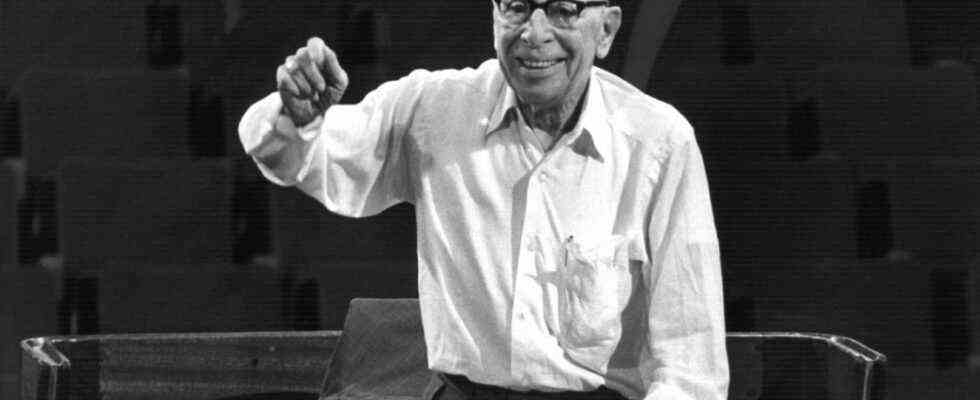So-called old works by great artists are sometimes the remnants of clarified exhaustion, or they reveal the old-age courage for reduction, for metamorphosis. This is a mystery – Titian, Verdi, Picasso, Stravinsky reaped their most beautiful fruits late. Late works, as Theodor W. Adorno once described the “last” Beethoven, are not like ripe fruit, “not round, but furrowed, even torn”. They lack “the harmony of classical aesthetics”. Fatal conclusion: “In the history of art, late works are catastrophes.” After the extravagant opening by Heiner Goebbels’ “A House of Call” (September 1st), the Musikfest Berlin is currently trying to illuminate the late Stravinsky more thoroughly than anywhere else.
Admittedly, the Russian Igor Stravinsky (1882-1971) brought the catastrophe into the world at the age of thirty: with the brutal spring sacrifice “Le sacre du printemps”, he and choreographer Sergei Diaghilew sparked the early Parisian scandal. Stravinsky established himself there as a brilliant bird of paradise. For the composer Claude Debussy he was “a young savage who wears excitingly loud ties, kisses women’s hands and steps on their feet. When he’s old, he’ll be unbearable …”
Not correct! As usually only Picasso, even the elderly Stravinsky showed himself to be the chameleon of the transformation of forms, styles and sound gestures. While the young composer had carried out all his conquests in France in the retro style of neoclassicism, he made spectacular changes in the technique and tone of his music after he emigrated to the USA in 1939 and became an American citizen. The “American” Stravinsky now scrutinized the entire history of art music feverishly, unearthed Renaissance and early baroque music and also sought to get to know Europe’s avant-garde at the time.
It is hard to believe that a 70-year-old could research the secrets of the twelve-tone and series technique of Arnold Schönberg and his pupil Anton Webern, which he freely adapted. And then also examined the scores of the very young generation of composers who renounced any work tradition, above all Pierre Boulez and Karlheinz Stockhausen. “Stravinsky demeure” admiringly decreed the innovator Boulez in 1951 – Stravinsky remains.
The late composer relied on compression of tone and spirit
The universalist Stravinsky, praised by the Berlin festival director Winrich Hopp, “became after the Second World War an icon of a European life that ranged from pre-revolutionary Russia through the two world wars to the time of the Cold War”.
The music festival is the platform for large orchestras to which the artistic director does not dictate the programs of his concept, but recommends them. So the Concertgebouworkest Amsterdam played Debussy’s “La Mer” under Daniel Harding, but in addition, with intellectual brilliance, Stravinsky’s last dance composition “Agon”, composed in 1957 for George Balanchine’s New York City Ballet. No story ballet like “Feuervogel” or the “Sacre”, but twenty minutes of contrapuntal compressed music of hard, pure timbre and body figures. Stravinsky’s confession that he knows “that parts of my agon contain three times as much music as some of my other works of the same duration” is understandable when listening to the demanding listening.
Is this really the work of a 78-year-old?
Compression of tone and mind. Whoever listens to Stravinsky’s late, seldom played compositions, which picks up easy comprehension, often thinks that they cannot believe their ears. Isn’t the 78-year-old’s short, glass-bead-like abstract piano concerto “Movements” an early work by Pierre Boulez, played illuminated by Tamara Stefanovich and the Mahler Chamber Orchestra conducted by Sir George Benjamin? How different, ingeniously rich in contrasts, yes, rumblingly aggressive, the 1924 concerto for piano and wind instruments, which the same pianist masters with brilliant virtuosity.
So much of Stravinsky’s pieces – in contrast to his famous works – are seldom heard in concert halls. The Musikfest Berlin (until September 20th) moves him forward brilliantly. And free: Kirill Petrenko and Francois-Xavier Roth will conduct the familiar, the “Firebird” and the “Sacre”, Robin Ticciati but Stravinsky’s very last, the short twelve-tone “Requiem canticles”, performed at Stravinsky’s funeral on the cemetery island of San Michele in his mythical city Venice.
The most conclusive and daring is the late Stravinsky of the Radio Symphony Orchestra under Vladimir Jurowski. He conducts, intellectually committed, in addition to the piano and wind concert, the five-minute large-scale variations in Webern style from 1964, glass “Aldous Huxley in memoriam”. And the almost unknown spiritual ballad “Abraham and Isaac”, intended for the people of Israel after Stravinsky’s trip to Jerusalem in 1962, premiered there. How baritone Georg Nigl copes with the extreme rhythmic and melodic accents and jumps, putting verses from Genesis chapter 22 from the first book of Moses under high pressure, arouses breathless admiration. Not only for the singer, but also for an old work of unspoiled vitality.

